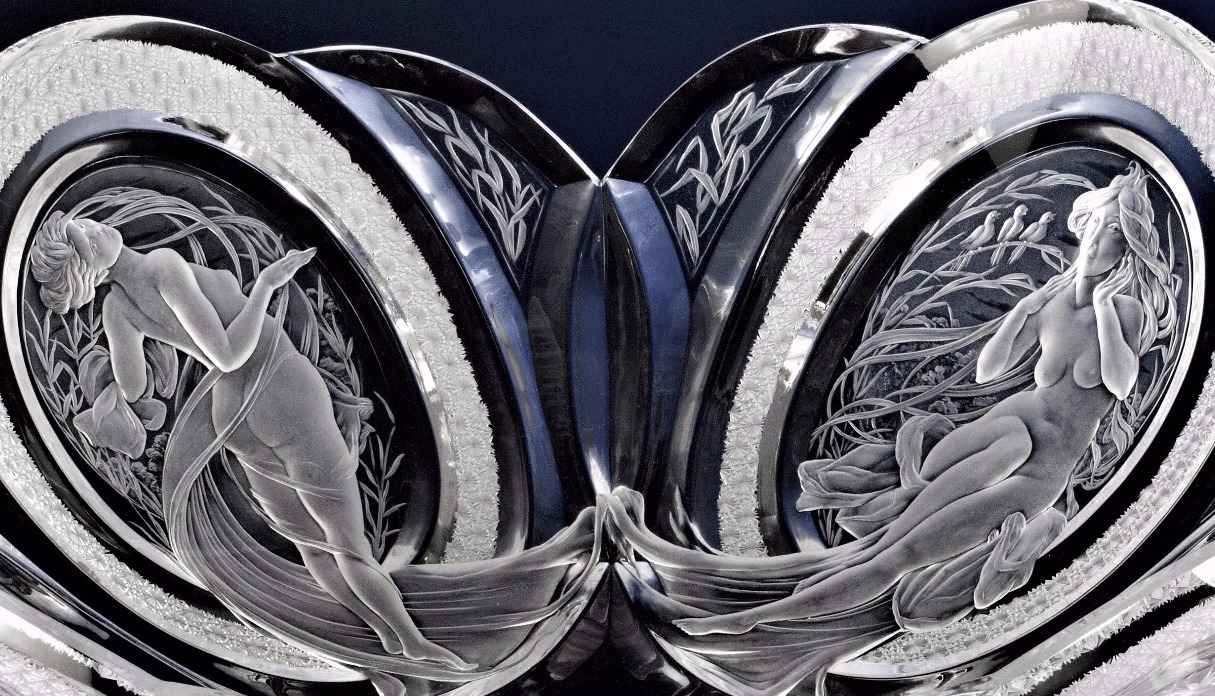About our techniques of glass decoration
Following in the footsteps of our ancestors

Glass cutting
Providing the glass with rich cut décor is a traditional handmade technique of decorating the glass. The cut décor is being applied particulary on vases, bowls, trays, decanters, bottles, baskets, glasses and other glassware.
Technically it is a mechanical removal of the glass with loose or bound abrasive. The cuts are being made with grindstones (mainly diamond, but also carborund or electrit cooled by water), rotated either on vertical axis or on horizontal axis on special cutting devices. The basic cuts are wedge-shaped, rotund, straight and prismatic. Each of these cuts is being used purposely to achieve various shapes - stars, octagons, claws, talons. The rich cut décor is often covering the whole outer part of the glass object and as such surface reflects the light on each of its edges, it creates a sparkling ornament.
The technique of glass cutting is being used since the 17th century. The origin of the delicate brilliance of the Czech cut glass is closely related to the invention of lead crystal glass. Crystal glass can be easily melted and has excellent optical features, it is also softer and thus better suited for cutting than potash glass. The luster of cuts is being achieved with polishing in an acid. Initially the crystal glass contained 30 % of lead oxide, nowadays the content of lead oxide is usually 24 %. Originally, the crystal glass used to serve as an imitation of gemstones in Venice. In 1710, our ancestors from the towns Turnov, Jablonec nad Nisou and Železný Brod started to use it, too.
The cut shapes we are using nowadays are based on a profound technical and arts tradition of our region. The glass cutter has no to be accurate and skilled in the cutting technique and he must also have decorative imagination and sense of composition, in order to be able to combine the various shapes, shiny and matte parts and achieve the highest quality.
The application of rich cut décor is highly valuable handwork, which is enriched with sense of art and creative capacity enabling the creation of new decors.
Miroslav Valenta, former glass engraver in the company Sklo Šafránek

Glass engraving
The glass engraving is a very old and traditional technique of decorating glass objects by hand. Its history and technological principle goes as far back as to the ancient times, when a similar technique has been used to engrave cameos into natural and very hard materials - agate and later mountain crystal. the technical and artistic heyday was reached in the beginning of the 17th century, when this technique became classical and it lasted for the subsequent periods of baroque, rococo and classicism.
In Bohemia, glass engraving developed during the reign of the emeror Rudolph II., who was a great art lover. The natural materials have been increasingly replaced with molten glass and the raised demand for glassware facilitated the development of decoration techniques. The engraved glassware directly contributed to the worldwide renown of the Czech crystal glass and remains a royal craft to this day.
The glass engraving is specific for its handicraft, transferring the human feeling and skill into the image on the glass. It is technique, which is unfeasible and irreplaceable with modern technologies.
Why is it so special? Practically, it is about cutting into the surface of a glass object. With the help of single cuts and removal of the material the final image is being formed and shaped. Like the paintbrush to the painter, the chisel to the sculptor or the burin to the graphic artist, are the rotating cooper, carborund, electrit or diamond wheels to the engraver. The engraver spreads an emulsion of emery powder and paraffin or water to the circumference of the wheel, which creates a cutting disc with the ability to take away the hard glass material while leaving the necessary matte imprint behind. using various sizes and profiles of the wheels enables the engraver to take away large parts of the glass surface or to create miniature tableaus composed of many details. The engravers work is basically a classic relief, mostly a negative relief (the positive relief is being used to a much lesser extent), which is embedded to the surface of the glass. The engraving gains its vividness and plasticity with light shining through the glass objects.
Glass engraving is the most difficult technique of glass decoration. the quality depends on the time and precision, which the engraver devotes to his work.
Miroslav Valenta, former glass engraver in the company Sklo Šafránek

Back to The technique
